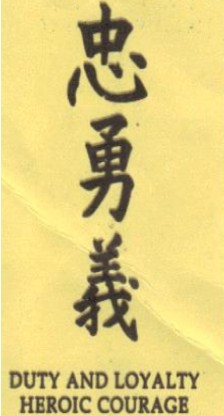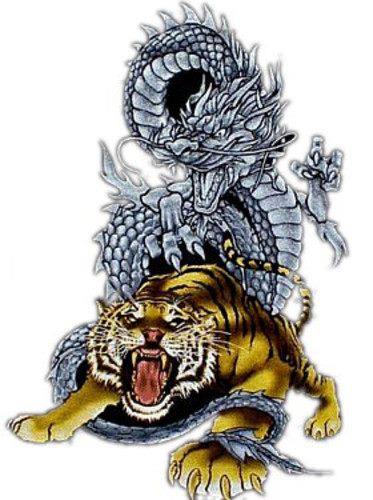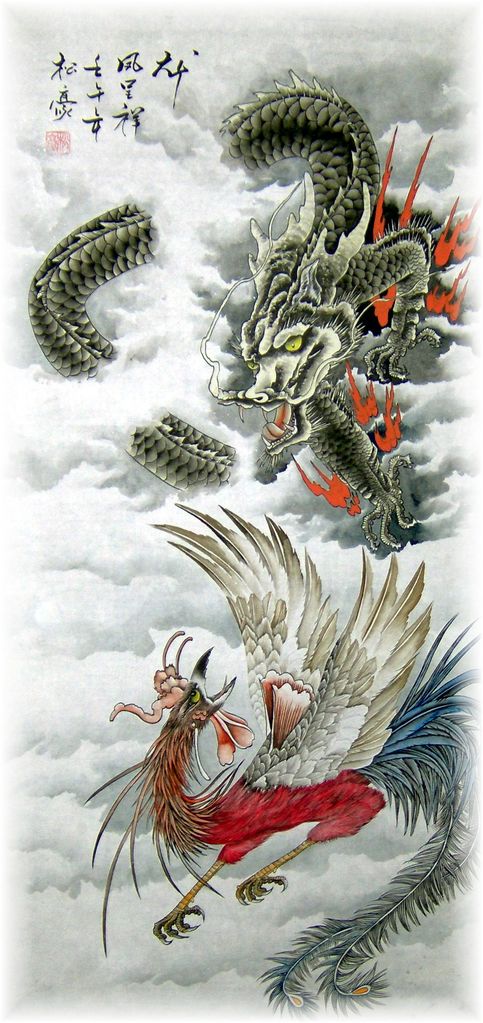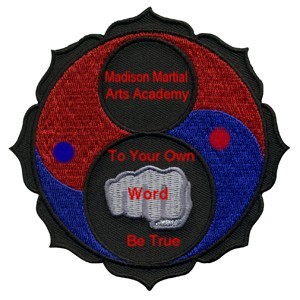1st, 2nd and 3rd Degree Black Belts are students.
1st Degree = Advanced Student = about two to five years of Martial Arts training
2nd Degree = Senior Student = up to ten years of Martial Arts training.
3rd Degree = Senior Advanced Student = up to 15 years of Martial Arts training. These three ranks traditionally wear black belts.
4th and 5th Degree Black Belts are skillful technicians. They are sometimes called "Renshi" in Japanese, or by the following descriptive Names:
4th Degree = Skilled Martial Artist = up to 20 years of Martial Arts training.
5th Degree = (Associate Master) Senior Skilled Martial Artist = up to 25 years of Martial Arts training. These ranks traditionally wear black belts, but in some systems, wear a Half Red & White Belt {black other side}
6th and 7th Degree Black Belts are teachers. They are sometimes called "Kiyoshi" in Japanese, or by the following descriptive names:
6th Degree (Master) = Teacher = up to 30 years training and teaching in the Martial Arts.
7th Degree = (Senior Master) Senior Teacher = up to 35 years training and teaching in the Martial Arts. These ranks traditionally wear a belt consisting of red and white blocks about six inches long around the belt, they may also wear just a black belt if they desire.
8th Degree Black Belts are "National Leaders," or "Important People" of the Martial Arts. They are often called "Hanshi."
8th Degree = (Elder Master) Important Person of the Martial Arts = This rank traditionally wears a belt consisting of red and white blocks about six inches long around the belt, they may also wear just a black belt if they desire.
9th and 10th Degree Black Belts are Grandmasters of the Martial Arts. They are often called "Hanshi."
9th Degree (Associate Grandmaster) = Red Belt with White Stripe.
10th Degree = Grandmaster = These ranks traditionally wear a solid Red Belt. Or a Red Belt With a Black Stripe, They may also wear just a black belt if they desire.
Below are the Ranks Used by the M.M.A.A
Beginners
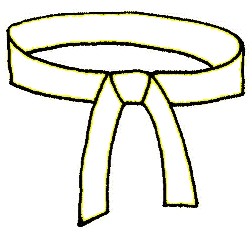
White Belt
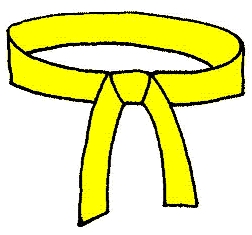
Yellow Belt
Intermediate
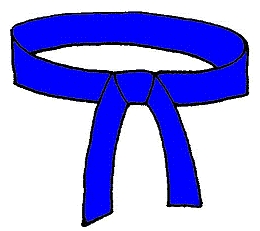
( GO-KYU )
Blue Belt
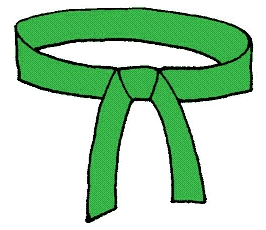
GREEN BELT ( YON-KYU ) (UNDER 16 W/WHITE STRIPE)
Advanced
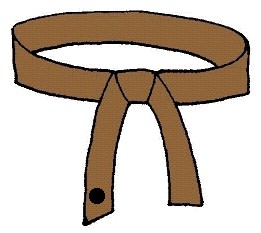
3RD DEGREE BROWN BELT ( SAN-KYU ) (UNDER 16 W / WHITE STRIPE)
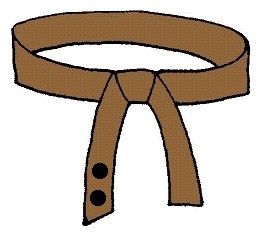
2ND DEGREE BROWN BELT ( NI-KYU ) (UNDER 16 W / WHITE STRIPE)
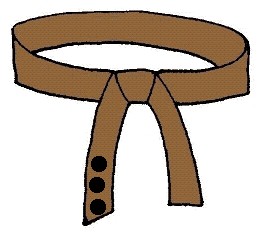
1ST DEGREE BROWN BELT ( IK-KYU ) (UNDER 16 W / WHITE STRIPE)
1ST DEGREE BLACK BELT ( SHO-DAN ) (UNDER 16 W / WHITE STRIPE)
2ND DEGREE BLACK BELT ( NI-DAN )
(INSTRUCTOR)
3RD DEGREE BLACK BELT ( SAN-DAN ) (SENSEI)
4TH DEGREE BLACK BELT (YON-DAN ) {RENSHI} Half Red & White Belt
5TH DEGREE BLACK BELT ( GO-DAN ) {RENSHI} (ASSOCIATE MASTER) Half Red & White Belt
6TH DEGREE BLACK BELT ( ROKU-DAN ) {KYOSHI} (MASTER) (RED & WHITE BELT BLOCK PATTERN)
7TH DEGREE BLACK BELT ( SHICHI-DAN ) {KYOSHI}) (SENIOR MASTER) (RED & WHITE BELT BLOCK PATTERN)
8TH DEGREE BLACK BELT ( HACHI-DAN ) {HANSHI} (ELDER MASTER) (RED & WHITE BELT BLOCK PATTERN)
9TH DEGREE BLACK BELT ( KU-DAN ) {HANSHI} (ASSOCIATE GRANDMASTER) (RED BELT OR RED BELT WITH WHITE STRIPE AROUND BELT)
10TH DEGREE BLACK BELT ( JU-DAN ) {HANSHI} (GRANDMASTER) (RED BELT OR RED BELT WITH BLACK STRIPE AROUND BELT)
MINIMUM TIME IN GRADE
1ST DEGREE TO 2ND DEGREE BLACK BELT (2 YEARS)
2ND DEGREE TO 3RD DEGREE BLACK BELT (3 YEARS)
3RD DEGREE TO 4TH DEGREE BLACK BELT (4 YEARS)
4TH DEGREE TO 5TH DEGREE BLACK BELT (5 YEARS)
5TH DEGREE TO 6TH DEGREE BLACK BELT (6 YEARS)
6TH DEGREE TO 7TH DEGREE BLACK BELT (7 YEARS)
7TH DEGREE TO 8TH DEGREE BLACK BELT (8 YEARS)
8TH DEGREE TO 9TH DEGREE BLACK BELT (8 YEARS)
9TH DEGREE BLACK BELT ( 8 YEARS) (CAN BE MORE THAN ONE IN THE SYSTEM)
9TH DEGREE TO 10TH DEGREE BLACK BELT (ONLY BY DEATH OR RETIREMENT OF CURRENT 10TH DAN)
Black Belt
Yudansha
The term Black Belt has become widely known as a way to describe an expert in martial arts where a practitioner's level is often marked by the color of the belt. The black belt is commonly the highest belt color used and denotes a high degree of competence, and often associated with a teaching grade though frequently not the highest grade or the "Expert" of public perception. It is also a relatively recent invention, dating from the 19th century, rather than an ancient custom.
Origin
The systematic use of belt color to denote rank was first used by the founder of Judo who first devised the colored belt system using obi and awarded the first black belts to denote a Dan Rank in the 1880s. Initially the wide obi was used; as practitioners trained in kimono, only white and black obi were used. It was not until the early 1900s, after the introduction of the judogi, that an expanded colored belt system of awarding rank was created. Other martial arts later adopted the custom or variation on it (e.g. using colored sashes) to denote rank including in arts that traditionally did not have a formalized rank structure. This kind of ranking is less common in arts that do not claim a far eastern origin.
Misconceptions
One common idea concerning the tradition of belts claims that the belt ranking system is an ancient aspect of traditional martial arts and that early martial artists began their training with a white belt, which eventually became stained black from years of sweat, dirt, and blood. In fact, Japanese instructors tended to provide certificates and, given the standard of cleanliness common in a traditional dojo, a student arriving with a bloodied or dirty uniform might not be allowed to train. The Student must be clean and the Gi clean
In some arts and schools there is the (often only half-serious, though equally often rigorous) opinion that the belt should not be washed; the idea that by doing that one would "wash away the knowledge" or "wash one's Qi away" might be related to this myth. Apart from risk of the dye running, there is the problem that as most modern belts are made with a cotton or nylon outer shell, but polyester batting and stitching to fill out the belt, the different shrinkage of cotton and polyester in hot water could cause the belt to come apart.
Relative Rank
Rank and belts are not equivalent between arts, styles, or even within some organizations. In some arts, a black belt is quite easy to obtain, usually expected in three years, while in others ten years may be common. Testing for black belt is commonly more rigorous and more centralized than for lower grades. It is a common belief that belts are handed out more loosely in the West than in Asia, where the custom of using the color of the belt to indicate a practitioner's rank originated. In Japan, however, rank often comes more or less automatically with time done and the black belt has little to do with the "master" level which westerners often think of when they hear the term "black belt".
Ability
In contrast to the "black belt as master" stereotype, a black belt commonly indicates the wearer is competent in a style's basic technique and principles. Since in many styles a black belt takes approximately three to six years of training to achieve, a good intuitive analogy would be a bachelor's degree: the student has a good understanding of concepts and ability to use them but has not yet perfected their skills. In this analogy, a master's degree and a doctorate would represent advancement past the first degree.
Another way to describe this links to the terms used in Japanese arts, Sho-Dan (for a first degree black belt), means literally the first/beginning step, and the next grades, nidan and sandan are each numbered as "ni" is two and "san" is three, meaning second step, third step, etc. The shodan black belt is not the end of training but rather as a beginning to advanced learning: the individual now "knows how to walk" and may thus begin the "journey".
As a 'black belt' is commonly viewed as conferring some status, achieving one has been used as a marketing 'gimmick', for example a guarantee of being awarded one within a specific period or if a specific amount is paid. Some schools place profit ahead of ability when using these tactics and are sometimes referred to as Mac-Dojos
Teaching
In some Japanese schools, after obtaining a black belt the student also begins to instruct, and may be referred to as Senpai (senior student) or Sensei (teacher). In others, a black belt student should not be called Sensei until they are San-Dan (Third Degree Black Belt), as this denotes a greater degree of experience and a sensei must have this and grasp of what is involved in teaching a martial art.
Some martial art schools use embroidered bars to denote different levels of Black Belt Rank, as shown on these Taekwondo 1st, 2nd, and 3rd Dan black belts.
Higher grades
In the Japanese martial arts, the further subdivisions of black belt ranks are called Dan grades where more stripes means higher rank. Yūdansha (roughly translating from Japanese to "person who holds a black belt") describe those who hold a black belt rank. While the belt remains black, stripes or other insignia can be added to denote seniority. In some arts, very senior dan grades will wear differently colored belts such as in judo and some forms of karate where a Sixth Dan will wear a Red and White Belt, which becomes Red only at even higher ranks. These other colors are often still referred to collectively as 'black belts'.


